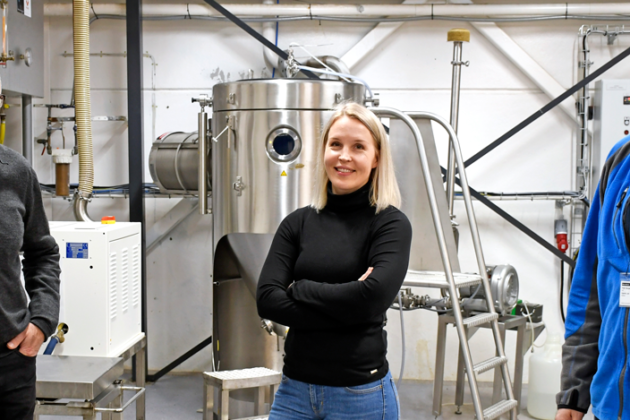Potential for high value creation from fish waste

The next time you remove the skin and bones from your fish dinner and throw them in the bin, you might want to keep in mind that you are disposing of something that could be worth NOK 8500 per gram!
Admittedly, there is a long way to go before fish waste becomes worth its weight in gold. However, scientists from Nofima and UiT – the Arctic University of Norway are now embarking along this path.
“Our starting point is the environment and sustainability. Making sure that we take full advantage of absolutely all the resources we harvest from nature”, says Kjersti Lian at Nofima.
May be worth more
“We are looking at the values we can extract from the parts of fish that are currently not worth that much to producers”, explains Peik Haugen. Peik Haugen and UiT have coordinated the research project that is funded by the EU. In addition to Nofima and UiT in Tromsø, participants include Umeå University in Sweden and Universidade NOVA de Lisboa in Portugal.
“Currently, we do utilise all parts of the fish we catch, but the parts that are not for human consumption are worth an average of only two kroner per kilogram”, Haugen explains. This residual raw material consists of offcuts, blood, entrails, heads, tails, fins, skin and bones from fish caught in the wild such as cod and from farmed fish such as salmon. Products such as fish oils (omega-3), fish meal, protein powder and animal feed are produced from residual raw materials.
The scientists started their trials at Nofima’s laboratories. They place the raw materials into a machine and add enzymes. Within a few hours, the materials have been broken down into three different products: oils, proteins and solids – which are mainly the remains of fish bones.
Then, the treasure hunt begins.
Bacteria from the Arctic
“Tromsø is home to our national biobank called Marbank. This is a large archive containing more than a thousand frozen bacterial strains. Most of them have been taken from the seabed along the coast and in the Arctic. We have taken a few different types of bacteria, cultivated them and allowed them to interact while providing them with nutrition from the proteins we made from the raw material”, explains Haugen.
And that is not all; the bacteria have been given very special working conditions. They work on a surface of biogranules which were originally developed at the Norwegian Technical University College (now NTNU) in 1989.
“These granules look like plastic and are currently used all over the world to clean wastewater. The process involves microorganisms living on the surface of these plastic granules which then purify the water by consuming ammonia and other things we want to get rid of. This then turns into other, less dangerous substances. In other words, we take a robust Norwegian technology from the 1980s and use it in a whole new context”, explains Jan Arne Arnesen at Nofima.
Unique molecule
Arnesen points out that what is now happening is exactly the same process experienced by every owner of a plastic boat: A slimy, green layer called biofilm forms on the biogranules. This is where the magic happens: New molecules are formed.
“What we get out at the other end is a kind of black box of content, which we then need to investigate in order to find out if the bacteria have produced anything we can utilise.”
So far, scientists have been able to identify just under 20 molecules that the bacteria have created using the residual raw material. Some of the molecules are particularly valuable. For example, one of them is widely used by pharmaceutical companies in both blood pressure and allergy medications. The value of this one molecule alone is NOK 8500 per gram!
“These molecules hold such a high price because so far they are only made artificially. Here, we have managed to make them using a natural method.”
“The success lies in the collaboration between the bacteria and the environment they are exposed to. Normally, we cultivate and use one bacterium at a time, but when we mix them in a community – they trigger each other and create completely different types of molecules compared to what they are able to manage alone. If you add different nutrients or expose them to different temperatures, you get completely new results”, explains Haugen.
New jobs?
The way forward for the scientists now is about developing the discoveries they have already made. Perhaps in a few years, both new companies and new jobs will have been created as a result of these findings.
“In addition, we will of course work to ensure that no waste is created during this process. We are left with a whole battery of molecules when the process is complete. Not all of them can be sold and utilised further, so we must find a process to save as many of them as possible. For example, some of them can be put back into production and used as new growth media for bacteria”, Lian explains.
So far, the research has been going on for three years and has cost approximately NOK 20 million. The largest partners are Norwegian, headed by the Research Council of Norway. Norway is funding approximately half of the project that is called: Micro MBT.
“Finding something that can be sold and create value is of course an important goal, but the increased knowledge that is gained through our research is just as important. We have a lot of students involved in the projects and we feel that it is all about discovering even more. For this specific project, we now want to introduce a new type of expertise among the partners so that new steps can be taken”, Haugen explains.
“Put it this way, it is not that often we get the champagne out when we make a breakthrough like the one we have managed here. However, the corks start flying when we get funding for new major research projects”, says Arnesen smiling.
Contact persons
Research areas
Bioprocessing
Topics
Residual raw material

